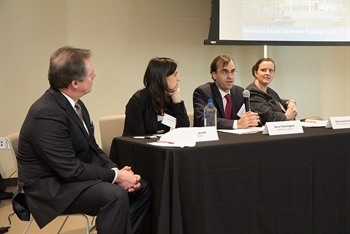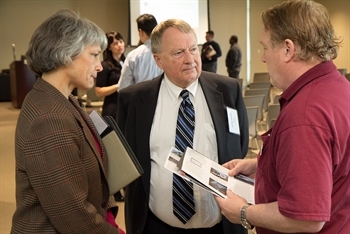The Chicago region’s 284 municipalities are never short on capital projects, but what about the money to make them happen? Ever-tightening budgets have forced them to identify new strategies and financing tools to supplement traditional funding sources to implement projects. One such financing tool is public-private partnerships or P3s.

Expert panel: Samara Barend, AECOM; David Pennington, BMO Harris Bank;
Erin Lavin Cabonargi, Public Building Commission; and Bob Fitzsimmons,
MPC Board of Governors and Chair Government
Relations Committee
Ryan Griffin-Stegink
Often it’s the larger P3 projects at the top of mind, the $3 plus billion Elgin O’Hare Western Bypass, Midway Airport, but mid-market projects such as village halls, police stations, and water and sewer infrastructure are also potential P3 candidates.
On Friday, Feb. 21, the Metropolitan Planning Council and Metropolitan Mayors Caucus co-hosted a forum in Carol Stream, Ill., called “Breaking New Ground: Innovative Financing Strategies for Municipal Projects.” Designed to provide more information about financing municipal infrastructure with private investment, the forum brought together municipal leaders and investment experts to discuss an important pathway to funding for communities: P3 and collaboration.
Prior to the event we asked municipalities to submit projects to use as potential case studies during the forum. We received projects ranging from $350,000 water mains to $5 million police stations. But we learned from our financial experts at BMO Harris Bank and AECOM that a $5 million project on its own is not a good P3 candidate. It’s likely more cost effective for the municipality to implement it through the traditional tax-exempt bond market (a value for money analysis). But that doesn’t mean that communities shouldn’t pursue a P3; it just means that if they do, they may want to think collaboratively, and communicate with their neighbors about what needs to get done more broadly, because there is private infrastructure capital available, that, for the right project, it would make sense to take advantage of.
We also learned that many municipalities need to build a certain infrastructure asset class; specifically we heard the need for public buildings such as police stations. At the forum, our experts, Samara Barend, vice president and PPP director for North America, AECOM; Erin Lavin Cabonargi, executive director, Public Buildings Commission; David Pennington, managing director, BMO Capital Markets; and Bob Fitzsimmons, MPC Board of Governors member and chair of the Government Relations committee, explained how a different approach to planning and implementing infrastructure in the region would be an avenue to accessing private infrastructure capital.
Aggregation
The Chicago region has more municipalities than any other in the country—284. That means it has more police and fire stations and town halls, and more entities building and repairing water mains. Because of this, projects tend to be smaller in cost. But what if the municipality wanted to consider a P3? How could it access private investors to begin that discussion? One good way to do it would be through aggregation of projects.

Municipal leaders learn about P3 infrastructure financing and
development
Ryan Griffin-Stegink
Private infrastructure investors have a threshold of about $20 million. To meet that threshold, aggregation—or bundling—of projects across asset classes is necessary to access private capital and could result in cost savings to boot. So in our police station example, if several municipalities worked together on financing, construction timelines, procurement and even project delivery, a P3 might make financial sense. Further, they could realize savings by using a single point of entry for implementation.
It is not new for municipalities to cooperate to achieve efficiencies; for instance, neighboring communities often contract with the same water provider or garbage collector to secure a lower cost. However, collaboration for infrastructure projects is relatively untested—and metropolitan Chicago has become a national proving ground for this approach. Since 2009, 23 suburbs in South Cook County have been working together to advance jointly adopted redevelopment, and more efficient and effective housing and community development strategies.
Intergovernmental agreement act
Aggregation of projects makes sense, because the economy doesn’t follow political boundaries and in an era of declining fiscal support from the federal and state governments, communities do better at accomplishing goals if they work with each other. In Illinois there are many legal paths to allow for the aggregation of projects.

Carol Stream Mayor Frank Saverino
Ryan Griffin-Stegink
Article VII Section 10 of the Illinois Constitution allows units of local government to work together, and even encourages collaboration. It provides that:
Units of local government may contract or otherwise associate among themselves, with the State and with other states and their units of local government to obtain or share services and to exercise, combine, or transfer any power or function, in any manner not prohibited by law or by ordinance. Further that local governments may contract and otherwise associate with individuals, associations, and corporations. Participating units of government may use their credit, revenues, and other resources to pay costs and service debt related to intergovernmental activities.
The constitution even spells out that the "State shall encourage intergovernmental cooperation and use its technical and financial resources to assist intergovernmental activities."
It does this through the Intergovernmental Cooperation Act. The act grants public agencies the authority to combine powers to perform services. Similarly, the Governmental Joint Purchasing Act allows agencies to join powers to make bulk purchases of supplies and services.
One such partnership already underway is an intergovernmental agreement with the Metropolitan Water Reclamation District. The Public Building Commission will evaluate energy-reduction opportunities at its facilities to save taxpayer dollars, including an in-depth audit of how power is used at District facilities.

Municipal leaders discussing infrastructure needs with Batavia
Mayor Jeff Schielke and Edith Makra of the Metropolitan Mayors
Caucus
Ryan Griffin-Stegink
Life cycle costs
Often when building infrastructure, only capital costs are considered. A building will gradually decline and the municipality must perform capital work, which is disruptive, expensive and often not planned. While P3 implementation can sometimes mean higher upfront capital costs, municipalities can transfer risk to the private sector on the long-term operations costs, resulting in lower total life cycle costs of the asset. Under a P3 structure, operations costs are factored up front, and regular preventative maintenance is scheduled, making for a stable, planned budget and a better maintained building. It can also save municipalities money in the long term from costs associated with a disaster. For example, if a building floods, it is the responsibility of the private sector to cover those costs.

Ryan Griffin-Stegink
Skillsets
It can be advantageous for municipal governments to partner with non-profit public entities formed under the Illinois Public Building Commission Act to implement projects. These entities’ core mission is to build infrastructure. The Public Building Commission, for example, can leverage financing and, thanks to its long track record, make building and maintaining infrastructure more efficient. The Commission has a broad range of powers such as design, build, finance, operate and maintain infrastructure as well as eminent domain and bonding authority. It has built public buildings for the City of Chicago, such as schools and libraries, but has the authority to work statewide.
The lesson we heard is that municipalities must think differently about their capital plans. Taking these approaches to planning and building infrastructure can open the doors to new capital markets and save money. Modernizing Chicagoland's aging infrastructure will put us back on the path of economic growth. MPC will continue to partner with Chicago-area decision makers, to fundamentally change how we invest in infrastructure and deploy these new financing tools when appropriate.
AECOM: Municipal Infrastrcutre Financing Overview and Select Case Studies
AECOM: Long Beach Court House: P3 Case Study
BMO Harris Bank: Municipal Infrastrcutre Financing Overview and Select Case Studies
Public Building Commission: Overview of the PBC and select projects
Public Building Commission: Terms and Tools for Public Infrastructure Development and Finance.
This event was generously sponsored by: